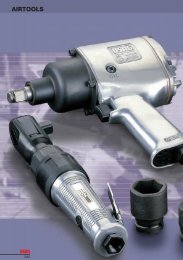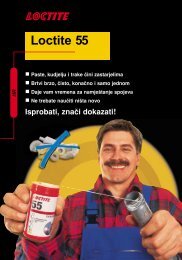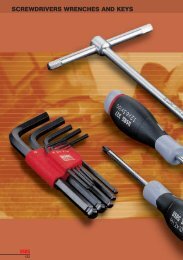Industrial seal self study guide - SKF.com
Industrial seal self study guide - SKF.com
Industrial seal self study guide - SKF.com
You also want an ePaper? Increase the reach of your titles
YUMPU automatically turns print PDFs into web optimized ePapers that Google loves.
BASIC SEAL TYPES (cont.)<br />
As was earlier stated, <strong>SKF</strong>’s standard nitrite <strong>com</strong>pound provides good<br />
service in most <strong>seal</strong>ing applications from -40˚F to 250˚F (-40˚C to<br />
121˚C). However, silicone, polyacrylate, Longlife or PTFE may be more<br />
suitable for and should be considered for temperatures outside this<br />
range.<br />
For more information on the temperature <strong>com</strong>patibility and abrasion<br />
resistance of various <strong>seal</strong> lip materials, turn to Chapter 4.<br />
When a <strong>seal</strong>’s basic<br />
function is to retain,<br />
face the <strong>seal</strong> lip toward<br />
lubricant (fig. 2g).<br />
When the <strong>seal</strong>’s basic function<br />
is to exclude, face the <strong>seal</strong> lip<br />
toward contaminants (fig. 2h).<br />
For retention/exclusion applications,<br />
a <strong>com</strong>bination of <strong>seal</strong>s in a unitized<br />
assembly can be the best solution<br />
(fig. 2i).<br />
Most applications for shaft <strong>seal</strong>s involve the need to retain or separate<br />
lubricants from some form of external contaminant or abrasion. But<br />
many times it must be determined which is more important, retention<br />
of lubricant or exclusion of foreign matter.<br />
Retention<br />
When the <strong>seal</strong>’s basic function is to retain lubrication, pressure, or both,<br />
the lip of the <strong>seal</strong> (generally the spring side) must face toward the<br />
lubricant or the pressure being retained and generally be spring<br />
assisted (fig. 2g).<br />
Exclusion<br />
Most bearings fail from the entrance of foreign material and from the<br />
loss or degradation of lubricant. Dirt, abrasives, water and other liquids<br />
can interfere with the film of lubricant required to support the moving<br />
parts of a bearing in a <strong>seal</strong>ed system. Reliable excluders generally<br />
include V-Rings and non-spring loaded <strong>seal</strong>s.<br />
Therefore, it’s vitally important for the <strong>seal</strong> to keep those materials<br />
from entering the bearing cavity. When the <strong>seal</strong>’s basic function is to<br />
exclude, the lip of the <strong>seal</strong> should face toward the contaminants<br />
instead of toward the bearing (fig. 2h). However in this case, only<br />
grease lubrication should be used since oil loss could be excessive.<br />
Retention/Exclusion<br />
Some extreme applications require the <strong>seal</strong> to perform both the<br />
retention and exclusion functions at the same time. For example, the<br />
<strong>seal</strong> may need to confine a lubricant while excluding dust or cleaning<br />
solutions. In this case, a special type of protection is necessary either<br />
a <strong>com</strong>bination of <strong>seal</strong>s back-to-back or dual <strong>seal</strong>ing elements within<br />
one unitized assembly (fig. 2i).<br />
8







